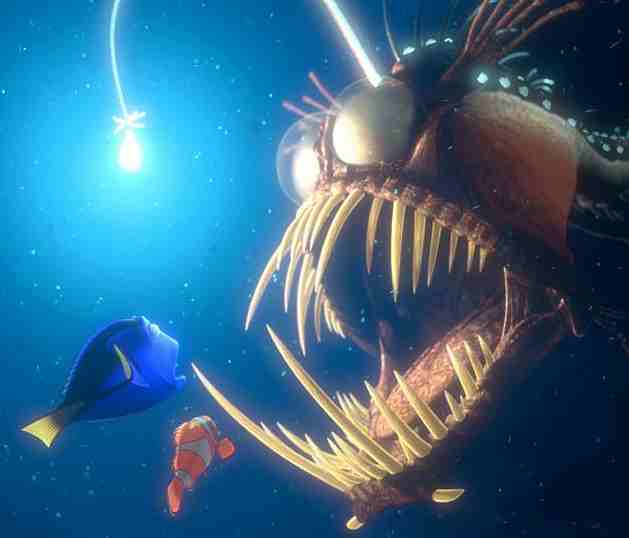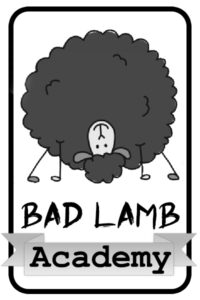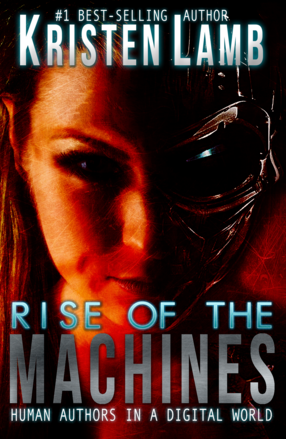From the WONDERFUL movie Finding Nemo
Last week we took a break away from talking about the antagonist because I needed you guys to be able to see how fiction looks when broken down to its fundamental parts. All fiction can be boiled down to cause, effect, cause, effect, cause, effect. But, beyond that, novels are broken into scenes and sequels. For those who missed this post, I highly recommend you go here.
So how do we know when to cut a scene? How do we knew when to begin and end chapters? How do we know what to trash and what to keep? Structure and conflict are like two gears.
Gears cannot turn unless there is another key wheel turning the opposite direction. No opposition, no power, no momentum. Same with a story.
All scenes have action. Action is more than a car chase or a bomb being diffused. Action does not mean a “bad situation.” All stories must have one main story goal, a core problem that must be resolved for the story to end.
Find Nemo.
I love studying children’s movies because they make it very easy to see and understand fundamental story structure.
In the Pixar film, Finding Nemo, what is the story goal for Marlin (the Clown fish father and protagonist)? Find his only son. How do we know when the movie is over? When Marlin and Nemo are reunited and safe at home, right?
Who is the Big Boss Troublemaker in Finding Nemo? The BBT is the character responsible for the story problem. The BBT is Darla the Fish-Killer, who we, the viewer, don’t even see until Act II. Darla is the horrid little niece of a dentist who likes to go diving. The dentist (Minion) collects little Nemo from the ocean as a birthday gift, beginning the adventure of a lifetime for Marlin and Nemo.
In Normal World, Nemo and Marlin live in a sea anemone. Overprotective father Marlin finally allows little Nemo to go off school (pun intended), even though everything in his life revolves around keeping his son safe. This decision to let Nemo go to school is the inciting incident. If Nemo never went to school then he would never have been taken by the diver dentist.
The turning point into Act One is when Nemo is taken. That gives the clear story goal and the journey of the story is clear—Finding Nemo.
Today we are only going to look at scene antagonists who drive the action.
Obviously Marlin will not find Nemo right away. That would make for very boring fiction. No, there are a series of sub-goals that must be met to find his son.
Marlin takes off after the boat, but then fails to catch up.
He loses the boat and all seems lost, when he runs into another fish, Dori, who says she knows which way the boat went. Marlin follows, renewed in the chase and hopeful he will find Nemo, but then his new ally turns on him wanting to fight. She is unaware why Marlin is following her. Marlin soon realizes the only link to finding his son is a fish ally who suffers short-term memory loss.
Great.
We, the audience, think the journey is over, but then she tells him she does remember where the boat went. Marlin wants to go after his son, but then Bruce the Great White interrupts.
At first Marlin and Dori look doomed, but then Bruce collects them to join him in the Fish are Friends Not Food meeting (think shark AA—Fish Anonymous). So instead of Marlin being able to continue on his journey, he must stop to attend this Shark FA meeting. He has to play along lest he get eaten and not be able to continue his journey. To make matters worse, the FA meetings are held in a sunken sub that is surrounded by mines. So we have outside obstacles—mines—and character obstacles—the Great White addict needing a Fish Friend for his meeting.
Marlin wants to look for his son. Bruce wants a fish friend to attend his FA meeting. This is what Bob Mayer teaches as a conflict lock. Please check out Bob’s books if you want to learn more.
At this point, Bruce is not Marlin’s enemy, but see how he is the antagonist? Bruce’s wants are in direct conflict with Marlin’s. Only one party can get his way. Marlin is held back from achieving his goal.
Through a fun series of events, Bruce ends up losing it and going after Marlin and Dori with the fervor of any addict as his shark buddies try to keep him from totally “falling off the wagon.” Marlin and Dori swim for their lives and while running, Marlin spots the diver’s mask (The diver dentist who took Nemo dropped his mask). The journey, otherwise, would have ended, but a wild twist of fate has renewed the search.
They have a clue and apparently Dori, the Forgetful Fish Ally that Marlin was going to dump at the first opportunity, can READ. He needs her. But they must escape Bruce and get the mask.
They escape Bruce by detonating all the underwater mines, but then both Marlin and Dori are knocked unconscious. They awaken and realize that they are pinned under the sub, which is now sitting precariously off an undersea trench. The mask and only clue to finding Nemo is wrapped around Dori. As they try to look at the mask, the sub starts to slide and they lose the mask.
Scene goal. Marlin wants to get the clue, but then the submarine sends them fleeing for their lives. Just as they grasp for the mask, it drops down into the deep.
See how Marlin is progressively worse off as the story progresses? He seems farther away from finding his son, when in reality these are the necessary steps to FIND Nemo.
All looks as if it is lost. Marlin goes to give up, but his unlikely ally encourages him to go on and swim down in the deep to find the mask. Marlin has a chance to give up. He could at this point go home and give his son up for lost, but that would make a seriously sucky story. Marlin is a control freak who is ruled by his fears. He has to learn to be the master of his fears in order to rescue his son. He must press on in order to find Nemo. He swims down into the abyss as all good heroes should.
Marlin WANTS to find the mask, but then he and Dori soon realize it is nothing but blackness and they cannot see to find the mask. All seems lost. Ah, but then they spot a pretty light in the darkness…which turns out to be an angler fish that wants to eat them both.

Marlin wants to find the clue (mask).
Angler fish wants dinner.
Do you see how every break the protagonist gets comes with a new test? This is why it is so critical for us to at least start out with our story’s log-line. What is our story about? Learn more about log-lines (BIG story goal), here.
If the screenwriters didn’t know that the overall goal was for a neurotic fish father to swim to Sydney, Australia to rescue his son from a dentist’s fish tank before Darla the Fish-Killer’s birthday…this would have been a booger to plot. In ways it still is. How do we get Marlin from the Great Barrier Reef to a dentist’s office in Sydney? This is where setting sub-goals (scenes) makes life easier. When we know the ending, the main goal then it is far easier to plot the course.
Each scene needs a key wheel—an antagonist—to provide the opposition that will drive forward momentum.
Bruce the Great White and fish-addict in recovery is not Darla the Fish-Killer (the BBT), but he does keep Marlin from his journey…finding Nemo, so he IS an antagonist. In retrospect, Bruce’s intervention was fortuitous in that they never would have been in the area of the ocean where the one clue—the mask—was dropped.
Every scene needs an antagonist. Scenes MUST have conflict. No conflict? Not story. No forward momentum. We must always take a good hard look at our scenes and ask the tough questions. Ask, “What is it my protagonist wants? Who is in the way?” If no one is in the way, then who can we put in the way? Conflict can even be as simple as allies disagreeing about a course of action—chase after bad guys or call the police and play it safe? Will the Elves take the Ring of Power to Mount Doom or will the Dwarves?
If everything is happening easily and all our characters are getting along? That’s a formula to bore a reader. Scenes where we have our protag thinking? That isn’t a scene, that’s a sequel. If a character is thinking, it better relate to something that just happened (a scene) and what to do next (next scene).
A “scene” that has characters talking about other characters is contrived information dump, not a scene. We can offload information in dialogue, but that cannot be the only purpose. Scenes are sub-goals—action blocks—that lead to solving the final problem.
I highly recommend reading Bob’s books for more about understanding antagonists and conflict. Then, watch movies and practice. Break apart movies. Who is the BBT? Who are the antagonists for each scene? What purpose does the antagonist serve other than standing in the way of the goal? We will talk more about this next week.
Do you guys have any questions? Insights? Opinions? Have any resources you would like to recommend?
I love hearing from you! And to prove it and show my love, for the month of May, everyone who leaves a comment I will put your name in a hat. If you comment and link back to my blog on your blog, you get your name in the hat twice. If you leave a comment, and link back to my blog, and mention my book We Are Not Alone in your blog…you get your name in the hat THREE times. What do you win? The unvarnished truth from yours truly.
I will pick a winner every week for a critique of your first five pages. At the end of May I will pick a winner for the grand prize. A free critique from me on the first 15 pages of your novel. Good luck!
Last week’s winner ofr 5 page critique is AMY ROMINE. Send your 1250 word document as an attachment to kristen at kristen lamb dot org.
Note: I am keeping all the names for a final GRAND, GRAND PRIZE of 30 Pages (To be announced) OR a blog diagnostic. I look at your blog and give feedback to improve it. For now, I will draw weekly for 5 page edit, monthly for 15 page edit.
Important Announcements
Make sure you join our LOVE REVOLUTION over on Twitter by following and participating in the #MyWANA Twibe. Read this post to understand how this #MyWANA will totally transform your life and your author platform.
My book We Are Not Alone–The Writer’s Guide to Social Media hit THREE best-seller lists for Kindle. #2 in Computers & Technology, #13 in Authorship and #17 in Advertising. THANK YOU!!!!! This book is recommended by some of the biggest authors AND agents in New York, so make sure you pick up a copy if you don’t have one already.
Also, if you want to learn how to blog or even how to take your blogging to a level you never dreamed possible…get your copy of Are You There, Blog? It’s Me, Writer today. This book hit #1 on the best-selling list in less than 48 hours after its release thanks to all of YOU!!!!! Not only will this book help you learn to blog, but you will be having so much fun, you will forget you were supposed to be learning.
Happy writing!
Until next time….








34 comments
11 pings
Skip to comment form
LOL, I think you read my mine. I’m nearing the end of my first draft and have been contemplating about scenes and where to cut them, etc. I would love to hear your thoughts on the best place to ENTER a scene – I know that’s something I need to work on, because I tend to “set the scene” every time and that’s not always necessary.
Thanks!
Author
As late into the action as possible. We will talk more about that soon :D.
I love these examples from Finding Nemo. It took you a long time to get this conflict concept through my head. It think that’s because I have worked hard to eliminate conflict from my life. Why would I want it in my books? Now, I know why. What a great blog. Thanks, Kristen.
Exactly! And, why would I torture my protagonist? Same reason. Love these lessons.
I had a couple of 2 year olds in the house when that movie came out on DVD and it played for about 3 straight months. The teaching points you’ve grabbed from it are really helpful. Love the gear analogy. You might just inspire me to dust off that novel I wrote a few years ago before sticking with NF!
Awesome illustration with Finding Nemo one of my favorite movies. Yes, that’s right, I said it. I love cartoon movies. My all time favorite is The Incredible’s… Oh yeah, action plots. Great way of breaking it down and showing us its different parts. Great Stuff!
Excellent post, Kristen. The Goal-Obstacle-Outcome format applies to every level of the narrative.
And you’re right, sometimes the best stories for studying narrative technique are made for kids!
I found this blog through Twitter and will be catching up on past posts ASAP. I’m loving this one and already thinking about scenes, conflict, and action in the new WIP. Also have a friend who saw her first ebook released in January and is already overwhelmed trying to figure out how to use social media to promote herself. I’ll be sending her the link to your book.
Question – Does every scene have to have a sequal? I
Does there have to be only one main goal? Or can the goal change over time? My protagonist has 3 different goals over the course of the story. They are all tied together by her “ultimate destiny” (the call to which she refuses just before the story begins and which sets her on the path for the novel itself).
Author
One main goal. The rest are sub-goals that MUST lead to solving that ONE BIG goal. This is the single largest problem I see with new writers. One story goal. In Romancing the Stone? Joan Wilder must rescue her sister. Fried Green Tomatoes? Mousy housewife must stand up to her abusive family. If our reader has no sense of the BIG goal, then it is impossible to generate dramatic tension. How can we see something is a setback if we don’t know what the finish line is? Anything else are just bad situations. This is why even some basic plotting ahead of time will help tremendously. Highly recommend Story Engineering by Larry Brooks.
This earlier post of mine might help. Hooking the Reader and Never Letting Go.
Hmmm…alright. I’m going to have to go back and think about this some more. Maybe I’m not really looking at her BIG GOAL the right way.
Thank you. 🙂
Ok. I think I’ve got it. My MC has made a bargain with an evil being in a posessed mirror. She wants what the evil one has to offer but paying the horrible price will give the thing the power to destroy the world.
At first though, the MC doesn’t figure out that she has to overcome the thing in the mirror’s temptations. She is pursuing these things. It’s only later on that she begins to realize the consequences.
How soon in the story does the MC need to know his/her goal?
Thanks for an excellent dissection of plot and sub-plots, goals and conflict-resolution. I found it very helpful as I’m editing my novel and trying to stay focused on the main plot line.
Conflict. Conflict. Conflict. This is a really good idea to look at Children’s movies for plot references because they tend to be more direct and obvious. The sub-plots are easier to spot and those are difficult for me in writing. Then we can apply our complicated adult stories (if that’s what you’re writing) to see how they function in the model. Hmmm. Fabulous food for thought. Thanks Kristen!
Excellent way to organize the process! I never thought of calling them sub-goals.
During NaNoWriMo last year I found that my plot was all over the place. The main character was just doing things that seemed meaningful when I wrote them, but afterwards stood out as random appendages. He was just going here and there, doing this and that, until I hit my quota of words. It seems like I would have had a better draft if I’d known the ending when I started, and then filled in the scenes that get the main character to that ending.
Love Nemo, wish I was still watching it with my “baby” who now wants a lip piercing but hey maybe Darla won’t get her.
Great job breaking the plot line down. Your posts on this have me often going, ooo ooo first plot point, or Midpoint!…much to the love of my wife 🙂
The duality of good writing starts with conflict that must accomplish two things: a “disaster or set-back” and an advancement towards the end (usually not seen until the end when the reader should be able to go “ah ha! Now I see!”)
You need to watch more movies with the “spawn” Kristen, he is turning out to be a muse 🙂
I’ve tweeted and fb’d and linked in my blog, because it finally all makes sense to me know! You rock, Kristen!
Wonderful post with clear examples, Kristen.
I’m going to write a novel about a wannabe novelist who has lost the thread of his story. His muse has gone missing, captured by the BBT ~ a Twit who hasn’t learned to Twitter.
As our insecure novelist sets out to reunite with his muse, and reclaim the main story goal, he suffers a series of comical mishaps and misadventures at the hands of various antagonists, including his ancient computer (which is filled with word gremlins that muck about with his purple prose).
After suffering through the crash of his hard-drive, and the loss of his patience, writer and muse are reunited, but must join forces to wrestle the central plot-line from a plagiarist who has stolen the story’s main goal in order to become an overnight success and sensation.
I’ll call it “Finding Conflict” . . . and dedicate it to you! Thanks, Kristen! 😀
Holy crap! You are Queen of Clarification. (Oh, sorry because this week represents Oprah’s final days, I promised that any time I used a word with a “Q” in it, I said I would add an “O” to the beginning of that word.
So, you are the oQueen. Do you realize I just compared you to Oprah, the woman with skillions of adoring fans.
Yeah, that’s about right.
But you really do know how to break it down.
I’d love to see what you could do with my Comp-101 classes. 😉
Incredibly insightful blog post! Really makes me re-think a particular chapter in my novel…
Love how you compared everything to Finding Nemo, as well! Great movie.
Kristen, you’re making me WISH I wrote fiction. Even memoir has cause and effect, though. And now, I’m going to spend the rest of the evening speaking *whale.*
This is great. A really clear breakdown. Thanks!
This actually helps me a lot! The story I’m working on was stalled because I didn’t really understand this concept. Thanks!
Thanks for this, it makes me evaluate one of my novels which I have struggled for years. It was my first one and it has gone through lots of revisions but something still feels not right. In reading this I realize there was no Main goal just a bunch of bad situations. There’s no BBT as I justified why each character did what they did. I like certain scenes from this novel and I’ve refused to do what I know it’s inevitable; either delete and move on or delete and start over. I’m trying to do things the right way, so thanks!
Neat stuff. I grasp scene and sequel at a conceptual level, though I have trouble really applying it as I write. You’ve got some nice concrete examples how conflict can work well.
Finding Nemo is a funny movie. Now I’ve gotta watch it again and look at this guideline.
Great blog. I never looked at it on this level before. I always knew it was a good movie, but your analysis has shown why it is great. Thanks.
This post was such a huge help to me! Each scene has an antagonist. It doesn’t have to be the same antagonist. I get it now! Thanks so much.
That is a great example! I don’t think I’ll ever watch Finding Nemo in the same way again:)
Whenever I read your posts, I feel like I’m in school…a really fun school that makes me more cool every time I go to class.
The other thing I love about this movie (and Cars does it well also) is that it’s Marlin’s fundamental character flaw — his inability to let Nemo grow up — that sets the story in motion, and leads him to an even greater redemption. Had he not freaked out about Nemo swimming past the drop-off, Nemo doesn’t challenge his authority and swim out to the butt. I mean boat. 😉
i feel as if the opening when his mate and other offspring was killed would be the inciting incident because if they never got killed his dad would be as over protective there nemo would never defy his father out of rebellion or spite
Author
No, it’s more of a prologue to reveal backstory. Inciting incident has to directly relate to the plot. Marlin could have moved them far away from the shelf and never let him go to school. If Nemo never goes to school there is no story.
[…] look at an example inspired by Kristen Lamb’s post analyzing the plot structure of Finding Nemo. The premise of Finding Nemo could be stated along the lines of: A father’s love for his […]
[…] find the right critique partner)Tips for Word ThievesTop 10 Best Resource Guides for e-Book AuthorsWhat ‘Finding Nemo’Can Teach Us About Story ActionWhen Search and Replace is Not EnoughWhere Do Authors Prefer You Buy Your Books?Write What You […]
[…] Story structure is all around us. Kristen Lamb explores the power of studying movies in What “Finding Nemo” can teach us about Story Action […]
[…] Kristen Lamb tells us What “Finding Nemo” Can Teach Can Teach Us About Story Action. […]
[…] articles. The first is Nathan Bransford on How to Write a Novel. The second is Kristen Lamb on Story Structure & Action. I just happened to read both of these on the same day, and had a few amazing lightbulb moments in […]
[…] mentioned yesterday that I came across a great article by Kristen Lamb about the importance of using conflict and antagonists to further a plot. While the entire article […]
[…] One of the hardest concepts for new writers to understand is the antagonist. I have even gone through great lengths to teach about the antagonist and his/her many faces. We have what I call the BBT (Big Boss Troublemaker), the catalyst for the story. No Sauron and the Ring of Power is just jewelry. No Emperor and Luke can continue moisture farming on Tatooine. No Darla the Fish-Killer and Nemo would be safe at home with his neurotic father Marlin (neat post about What Finding Nemo Can Teach Us About Story Action). […]
[…] What ‘Finding Nemo’ Can Teach Us About Story Action […]
[…] Lamb recently did a blog post on Story Action using Finding Nemo as her example. Detailed breakdown of the plot and story and an […]
[…] What ‘Finding Nemo’ Can Teach Us About Story Action […]
[…] There are many forms of amnesia that usually fall under the banner of retrograde or anterograde amnesia. Anterograde amnesia is the inability to form long-term memories. Think of Dori in Finding Nemo (refer to What Finding Nemo Can Teach Us About Story Action). […]